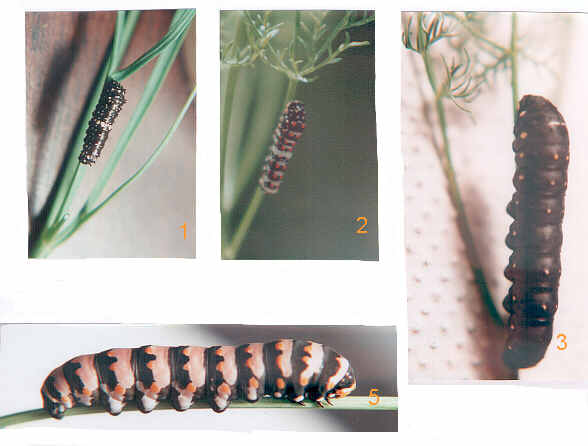
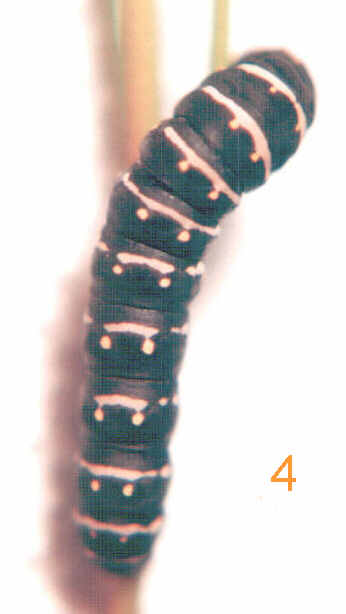
The Papilio indra complex in Utah
(Updated October,
2005)
Introduction:
Previous lepidoptera
publications describing the Papilio indra complex have labeled it
as rare, fragile(1),
isolated, and so forth. For example, William H. Howe describes it as follows:
"The Papilio indra complex shows a considerable degree of geographic
variation, especially in the southern parts of its range. Throughout its range
the species is generally uncommon and specimens are rare in collections.(2)"
Clifford D. Ferris and F. Martin Brown add, "Because of its isolated
habitats, indra is poorly represented in collections.(3)" Furthermore,
according to John Adams Comstock, speaking of P. indra indra in Calif,
"is one of our rare species, occurring in the higher altitudes of the
Sierras...It is a difficult butterfly to capture, being rapid and erratic in
flight.(4)"
(Italics added.)
But today, because of
work by researchers and by many collectors who have become impassioned with this butterfly, we know that it is not only more common than previously perceived, but also, it is well represented in some collections. In fact,
according to Col. C.F. Gillette(5), P. indra has been recorded in every county in Utah save four; Sanpete, Iron,
Wasatch, and Piute.
The Papilio indra
complex in Utah flies in a variety of habitats from desert swells, reefs, and
limestone hills to the tops of the Wasatch Mountains. In fact, the butterfly has
even been seen crossing valley floors between mountain ranges! It is true that indra does
fly in some hostile environments. Its population numbers have been known to
fluctuate drastically from year to year depending upon climate (precipitation)
and parasitism. One of the population stabilizing mechanisms of indra is
the fact that their pupae can prolong diapause (hibernation) for several years
in order to insulate against harsh or unfavorable conditions.
One
of the attributes that gives indra such an appeal to some collectors is its beauty coupled with its
geographic variation. The indra swallowtail's geographic variation is peculiar
in the effect that colonies which fly in moist montane habitat such as P. indra indra seem
to show much less individual variation than do colonies from the desert or from
a semi-arid origin such as P.
indra calcicola or P. indra minori. The
same phenomenon also seems to occur in California as montane colonies of P. indra pergamus
and P. indra indra show
a lower degree of individual variability as compared to the desert races of P. indra fordi and P. indra martini.
Utah
currently has four varieties of indra; three named subspecies which include the typical race, minori, calcicola, and
one soon-to-be named subspecies bonnevillensis. Unlike like its cousins from the machaon
group, Papilio indra adults
are not sexually dimorphic. In many Utah habitats, excepting most colonies of P. indra minori and P. indra calcicola,
indra flies
sympatric with Papilio zelicaon; the former usually flying 7 to 10 days after the latter. The two
species also share many of the same larval foodplants. However, P. zelicaon
generally has a broader range of foodplants as compared to P. indra.
Although
difficult and time-consuming, many collectors have been able to obtain
attractive series of the different varieties of indra
through rearing its caterpillars. One of the difficulties of raising indra in
the lab is the few species of plants--usually in the Lomatium and Cymopterus
genera--which the caterpillars will accept. Obtaining these specific plants many
times requires long distance travel. Another problem with raising indra in
the lab, which can be overcome through practices later discussed in this
publication, is their high susceptibility to microbial death. The two most
common varieties of microbes that kill indra immatures are viruses and bacteria.
Others
have obtained a decent series of some races of P. indra by
collecting adults on the wing. Although John Adams Comstock describes this
butterfly as being difficult to capture and erratic in flight, a little patience
can overcome this obstacle through observation. In other words, males oftentimes
will repeat their "erratic" courses as they fly similar aerial routes
and land generally in the same spots. By predicting this repetitious behavior,
and then moving to advantageous spots, specimens can be netted more easily. Some higher altitude males of P. indra indra
exhibit this repetitive flying behavior, and have even been known to pause from
their aerial stunts in order to land and bask on snow banks! (I.e. Bountiful
Peak, Davis County, Utah.)
Females,
on the other hand, are much easier to capture as they more casually flitter in
the vicinity of their larval hostplants. (The only exception to this is females
of P. indra minori
which tend to traverse their habitat in search of larval hostplant with much
more haste.)
(For more information on the distribution, habitat, larval host plants, subspecies, of the entire Papilio indra complex in the Western United States, please see Wayne Whaley’s outstanding and thorough research paper.)


1.
P. i. indra 4th instar on L.
graveolens from Davis County, UT.
2. P. i. minori 4th
instar on C.
terebinthinus
Grand County, UT.
3. P.
i. bonnevillensis
5th instar on L.
grayi
var. depauperatum, Juab County, UT.
4. P.
i. indra
5th
instar on L.
grayi
var “grayi,” Cache County, UT.
5. P.
i. minori 5th
instar on L.
junceum
from Emery County, UT.
PART
II: THE FOUR UTAH VARIETIES OF PAPILIO INDRA
General:
The
Type Locality of P. indra indra is vicinity of Empire, Clear Creek County, Colorado; Reakirt 1866.
It is the shortest tailed race; some individuals exhibiting nothing more than a
"stub." The nominate race is univoltine. The flight period in Utah
varies depending upon elevation, snowfall, and larval hostplant. In the Bear
River Mountains where P. indra indra
utilizes mainly Cymopterus terebinthinus between the elevations of 5000' to
7000,' indra
flies from mid-May to late July.
On
the other hand, higher up in the Wasatch Mountains, where the larval hostplant (L. graveolens)
grows at around 8,000' to 10,000', the flight period varies from around mid June
to early September.
Utah Distribution and Habitat:
As
discussed previously, the montane habitat of P. indra indra includes
the Wasatch, Oquirrh, Stansbury, Bear River, and Uinta Mountain Ranges. Higher
altitude males patrol and perch all day in search of females. Some of these
males have been known to descend several thousand feet to canyon floors to
nectar near rivers. (I.e, Provo Canyon, Utah County, and Big Cottonwood and
Millcreek Canyons, Salt Lake County.)
Bionomics:
As stated earlier, the
principal larval foodplant for P.
indra indra in the Wasatch Mountains is Lomatium graveolens,
and the larval foodplant in the Bear River Mountains is Lomatium grayi var. grayi (milfoil lomatium)
The ova is yellow-green
and is laid principally on healthy plants' peripheral ventral stalks. After a
day or so, the ova develops rings and then turns black before hatching. From the
time an egg is laid to the time it hatches is roughly six days in nature and
five days in the lab. (Assuming room temperature.)
The young first instar larva is black with a thin, white saddle. (Sometimes new hatchlings can have a silverish appearance before turning black.) As the larva moults into later instars, small white and yellow-orange speckles appear. Larvae of P. indra are much more timid than those of P. zelicaon. The mature larva varies from black with off-white stripes to nearly all black with small yellow-orange dots. Hibernation is as pupa. For some reason, most lab-reared pupae emerge after two years of winter. ( Some pupae have been known to diapause for up to three to four years.)
General:
The Type Locality of P. indra minori is
Black Ridge Breaks, Mesa County, Colorado; Cross 1936. Minori is
one of the most beautiful races of P.
indra. Its large size with long tails combined with thin to intermittent
cream bands and generous blue dorsal hindwing scales are diagnostic. Adults
display a significant amount of individual variation. The bands on some
individuals of minori are
completely obsolete; showing the phenotype of what essentially is a black and
blue swallowtail. It is the opinion of the author that this form kaibabensis
which most authorities treat as a distinct subspecies really is a genetic drift
morph of minori for
two reasons. First, the kaibabensis form appears at least seldomly in mostly all minori
populations. Again, its just an example of individual variation. Second, the
habitat and bionomics of the two taxa are virtually indistinguishable.
Males hilltop on the
tops of reefs, buttes, or even sheer peaks in search of females. In fact, minori
males have shown intense aerial battles against one another in competition for
females. Females, on the other hand, oftentimes fly in lower portions of buttes,
or even in desert floors or swells in search of its larval hostplant. (Females
only hilltop once to mate.) It is multivoltine depending upon rainfall; with up
to three broods per year.
Utah Distribution and Habitat:
The distribution of minori
in Utah is extensive. According to W.H. Whaley(6),
over 50 distinct colonies can be found over Central to South-Southeastern Utah
badlands. This distribution includes, but is not limited to, the West Tavaputs
Plateau, Cedar Mountain, San Rafael Swell, San Rafael Reef, Capitol Reef
National Monument, Henry Mountains, Cockscomb Ridge, La Sal Mountains, Abajo
Mountains, and Monument Valley south to Northern Arizona.
Bionomics:
The larval hostplants of minori
differ depending upon venue. In the San Rafael Swell, Cedar Mountain, San Rafael
Reef, Capitol Reef National Monument areas, larvae utilize Lomatium
junceum
(rush lomatium.) At the Cockscomb Ridge, Monument Valley, and Abajo Mts, larvae
use Lomatium
parryi (parry
desert parsley.) Also at Monument Valley and areas adjacent to Moab, larvae use Cymopterus
terebinthinus
(rock springparsley.) All of these larval hostplants are unique because they,
for the most part depending upon rainfall, stay green and healthy from spring
until fall; which accounts for the butterfly's ability to have multiple
generations in one year.
The ova is yellow-green; developing rings and then turning black
before hatching. The young larva is black with a white saddle. It is interesting
to note that young minori
larvae have a broader white saddle than young indra indra
larvae have. The large mature larva is gorgeously arrayed with bright pink and
black stripes strewn with orange dots. Immatures, unfortunately, are heavily
subjected to several varieties of parasites. Egg parasites have recently been
discovered in addition to the ever-so-prevalent small wasp parasites that kill
third instar larvae and maggot parasites that kill fifth instar larvae.
Hibernation is as pupa.
General:
P.
indra calcicola recently was described
from Southern Nevada. Colonies
of this butterfly in the State used to be referred to as as P. indra
nevadensis or P. indra nr. nevadensis. It is a long tailed race of indra.
Amongst all the subspecies of indra in
Utah, calcicola
shows the most drastic example of individual variation with specimens looking
like fordi, martini, panamintensis, and even pergamus. P. indra calcicola, for the most part, is univoltine with
less than 1 percent of lab-reared pupae emerging during the same year. Adults of
this Swallowtail fly early in the
year; from mid to late March to mid-May.
Utah Distribution and Habitat:
The distribution of P. i. calcicola in
Utah is restricted to Washington County.
Among other habitats, the butterfly is most easily encountered in Navajo
sandstone hill country North and Northeast of St. George. It is also found in
the Beaver Dam Mountains, Leeds Canyon and rumored to fly in the Pine Valley
Mountains as well. One type of habitat where calcicola seems to be less common is the Lava Ridges because of the rarity of
its larval hostplants there.
Bionomics:
P. i. calcicola immatures utilize two species of Lomatium in
Washington County. In the vicinity of St. George, Lomatium scabrum
(cliff lomatium) is the larval hostplant. Leaflets
of L.
scabrum burn off by mid to late May; which accounts for its one brood.
However, leaflets of Lomatium
parryi, which is its foodplant
in the Leeds Canyon area, do not burn off until the fall. As such, it is
plausible that calcicola could at least have a partial second brood in the vicinity of Leeds
Canyon. Admittedly, more research needs to be done in this area.
Under typical
conditions, females will only lay on healthier L.
scabrum plants located between rocks or at the base of desert washes because
these plants will thrive long enough to support the larva to maturity. However,
in certain years, when population numbers are extremely high, it is interesting
to note that females sometimes will oviposit on plants that cannot support the
larva to maturity. Some Navajo Sandstone hills North of St. George do not have Lomatium scabrum on them except for North-facing washes and slopes. These hostplants
survive well there for two reasons: First, these washes and slopes accumulate
more moisture and can support the roots of these plants. Second, plants in this
area receive less direct desert sunlight as compared to south, east and west
facing slopes.
The mature larva is
similar to P. indra minori and
is striped with bright pink-peach and black bands with yellow-orange spots. The
pupa is salmon in color and camouflages well against Navajo Sandstone. As is
true with all subspecies of indra, hibernation is as pupa. See below.
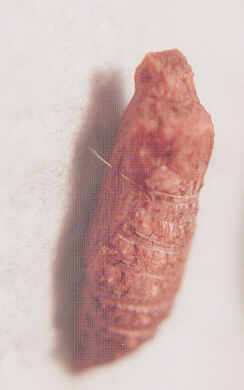 |
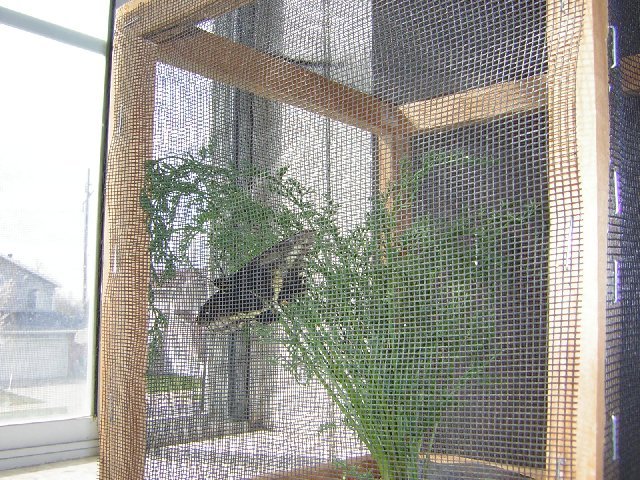 |
| Papilio indra calcicola pupa. | Papilio indra calcicola female ovipositing on host Lomatium scabrum in a cage. |
General:
Currently, P. i.
bonnevillensis is being named and described as a subspecies by Dr. Wayne H. Whaley(7)—in press. This butterfly was originally noticed but undescribed
by Col. C.F. Gillette(8) prior to 1986. In
2000, this race was unofficially designated by Whaley as "nigricampe"
or even "West Desert indra" by local collectors.
P. i. bonnevillensis is short to medium tailed, and has one flight per year. The strength of the flight varies depending upon winter precipitation. At 5000', bonnevillensis generally flies from mid to late April through to mid to late May. The presenter of this paper agrees with Wayne Whaley in describing this race as a valid subspecies for the following reasons: First, bonnevillensis is geographically isolated from calcicola. Second, calcicola hardly ever have short-tailed morphs; bonnevillensis does. Third, over a long series, bonnevillensis has consistently more blue in the dorsal hindwings as compared to calcicola. Fourth, some bonnevillensis females exhibit extremely wide dorsal forewing bands that rival the width of specimens of P. indra fordi. Fifth, calcicola documented larval hostplant Lomatium scabrum grows where bonnevillensis flies. However, to date, bonnevillensis immatures have not been found using L. scabrum. Sixth, mature larvae of bonnevillensis are drastically different to Washington County calcicola; but can be quite similar to Northern Utah P. indra indra.
Utah Distribution and Habitat:
Colonies of P. i. bonnevillensis
exist in many North-South ranges in Utah's West Desert
including but not limited to the Dugway Range, Thomas Range, Fish Springs Range,
House Range, Confusion Range, and Little Drum Mountains. All of these mountain
ranges contain Limestone and exist in the vicinity of what was Lake Bonneville.
These limestone hills is where the larval hostplant grows.
Bionomics:
The larval hostplant is Lomatium grayi var. “depauperatum.” This plant seems to die
off faster than any other host of indra. A first instar larva has perhaps one of the most slender white
saddles as compared to other subspecies of indra. As
the larva matures, this saddle has been known to disappear altogether. Third
instar larvae of bonnevillensis change their resting position to the
base of the hostplant where they are difficult to find. The mature larva has two
basic forms from mostly black with tiny yellow dots to black with medium cream
bands. (As a matter of fact, the previous name nigricampe means black
caterpillar(9)—.)
Papilio indra bonnevillensis pupa just before eclosion.
PART
III: HINTS ON FINDING IMMATURES OF PAPILIO INDRA:
Hint #1
Females prefer to oviposit on the underside of short--sometimes very
short--stalks or leaflets along the periphery of the larval host plant;
basically belonging to the genera Lomatium or Cymopterus. Many
times these short, peripheral stalks point tangentially away from the general
direction of the rest of the stalks on the plant.
Hint #2
Many plant species in these two genera are rock formation or soil
specific. For example, in order to find any larval host plant for Papilio
indra minori, it is first necessary to find the appropriate type of Moenkopi
Shale, Chinle, or Navajo Sandstone.
Hint #3
As indra immatures grow, they change their preferred resting places.
Ova
through third instar:
Look first for where an egg is most likely to be have been laid.
(See Hint #1.) If an empty eggshell is found, then look nearby for indra
chew marks. Young indra larval chew marks show a unique skeletonizing
effect on the leaflet, and can assure you that either a young larva either is,
or recently was on the host plant. If chewmarks are found, turn over that
leaf. If the larva is not in sight, one of two possibilities exist: Either
it has died, or it has grown and become at least a third instar, and has changed
its preferred resting position. Note: Third instar is the phase when an
indra larva most drastically changes its resting preference.
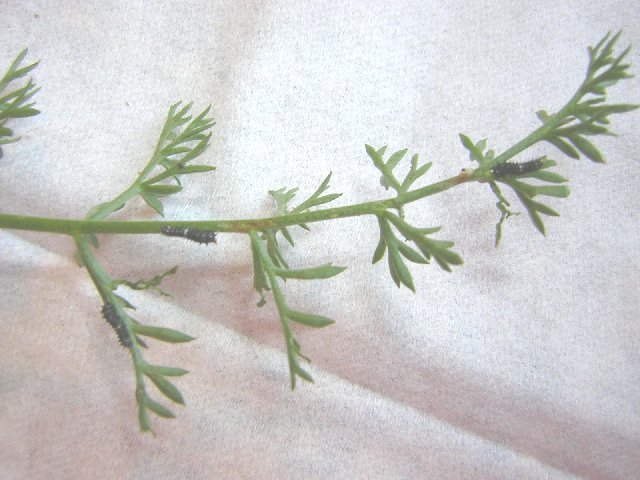
Papilio indra calcicola first instar larval chew marks show a unique skeletonizing effect on the leaflet.
Third and Fourth instar:
As stated earlier, third instar larvae move away from the periphery
of the food plant. They then prefer to rest on the bottom one-fifth
portion of more centralized stalks of the host plant. Finding them can be
difficult; even for experienced collectors! At this point, a technique of
getting on your hands and knees and patiently sifting through every stalk is
required. Sometimes this sifting can become a long and tedious task.
However, patience and skill usually will enable you to find the larva.
As larvae grow and become fourth instar, looking again for chew marks and
even frass can be helpful. Instead of seeking out the peculiar
skeletonizing chew marks of a first or second instar, look for stalks with
entire leaflets missing and stalks chewed down. Also, using tweezers is
especially critical while seeking out third and fourth instars as larvae fall
off of the plant when disturbed.
Fifth instar:
When a fourth instar moults into its final stage, it may, for a day
or so, maintain a rest position similar to that of a typical third or fourth
instar; on a center stalk at the base of the plant. However, fifth instars also
may leave the plant altogether and rest on the dirt, in a shallow crevice, or on
a rock adjacent to the host plant. During this stage, fifth instars can be
equally as difficult to find as third or fourth instars, or they can be
surprisingly easy to encounter.
Examples of fifth instar indra larvae that can be easy or
very difficult to find. The figure on the left shows a P. indra bonnevillensis
last instar larva on Lomatium grayi that, obviously,
is very conspicuous. Can you find the P. indra calcicola fifth
instar larva resting adjacent to the Lomatium scabrum plant in the figure
on the right? Click here
or on the photo for closeup
shot of that larva.
Hint #4
Seek out large, healthy, and lush host plants within a colony.
Females prefer to oviposit on healthy host plants because it increases the
chance that the larva will thrive and pupate. (Obviously, female oviposition
preference is an instinctive process; not a cognitive one.) These plants are
healthy because of their root systems. Host plants with unusually healthy root
systems are such because of two reasons: First, they received more water;
second, they are more protected from direct sunlight as compared to other
individual plants. Healthy host plants are most commonly manifested as plants
situated between rocks, plants located in desert washes or at the base of a
desert wash protected from the sun by a rock cliff, or plants on mountain slopes
which receive more hours of shade than do other individual host plants. Other
host plants which thrive; but not necessarily due to healthy root systems, are
plants that have been pruned. By pruning plants in the summer or fall, whether
it be by livestock or by collectors creating egg traps, new growing stalks
thrive because they are not impeded by the previous year's dead stalks.
Hint #5
Look for isolated host plants within a colony. Many times, if the
colony is large and host plants for Papilio indra are plentiful, finding larvae
by looking on all of the healthy host plants can still be monotonous. In order
to alleviate this problem, it is best to seek out small pockets within the
colony where host plants are more scarce. With fewer host plants to lay on, it
is more likely that a larva would be found on any given plant within the pocket.
Hint #6
Examine the peripheral plants in a colony. An experienced collector
oftentimes will map out where the host plants start and where they stop in order
to assess the host plant's distribution boundary. With females flying in and out
of the boundaries of the distribution of the larval host plant, many times
plants scattered along this periphery are visited much more often than are
similar plants located in the interior of the colony.
Hint #7
Most of the time, from generation to generation, or from year to
year, P. indra females tend to oviposit on the same individual plants.
Therefore, if your collecting needs requires repeated visits over a few years,
first investigate individual plants that you know have yielded immatures on
previous visits.
Hint #8
Bring tweezers. As briefly discussed earlier, indra larvae can fall
off the host plant with the slightest disturbance. (Always use your hand to
secure the larva in the event that it falls as you pull the stalk.)
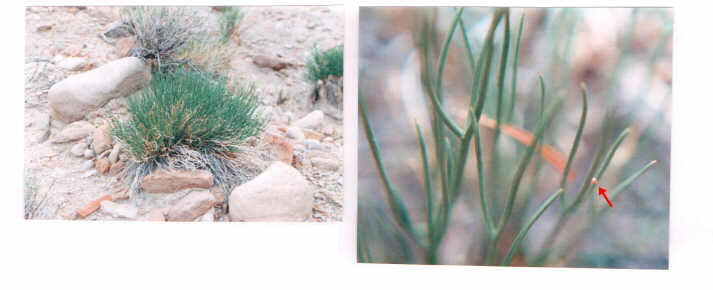
|
Distance shot (above) and
closeup (right) of P. indra minori host Lomatium
junceum taken in Emery |
PART IV: METHODS OF REARING IMMATURES OF PAPILIO INDRA:
Introduction:
There are basically three methods available to accomplish the successful rearing of P. indra caterpillars in the lab. They are the open aquarium method, the closed container method, and the potted plant method. Advantages and disadvantages of all three methods will be discussed hereafter.
Whether to rear P. indra in a closed container or in an open aquarium basically is a function of how many larvae you have. If you are planning on rearing more than just a few caterpillars, it is recommended that you use the open aquarium method. If you have only a few caterpillars, you might want to try the closed container method. Because of the initial setup time, it seems to make sense that you should use the open aquarium method only if you have enough immatures to justify that step.
Why Larvae Get Sick:
The two main airborne microorganisms that can aggressively infect and kill any lepidoptera larvae--including P. indra--are viruses and bacteria. Larvae of P. indra can be prone to getting sick using either the open aquarium method or the closed container method as well as the mismanagement of the lab hostplant.
Microbial death is most commonly seen because of three factors which are feeding larvae old foodplant, overexposing them to their own frass--see tip #2 below, or exposing them to containers that have not been properly sanitized. It is true that viruses and bacteria thrive and spread much more in a closed container type of environment. However, even larvae in an open aquarium environment can get sick for these same reasons.
Proper Handling of Lab Hostplant:
As you plan on rearing indra, think through well in advance when and how you are going to obtain your supply of larval hostplant. It is profitless to collect indra immatures without a foreknowledge and a commitment of how you are going to get enough hostplant on subsequent visits to get your larvae through to pupation.
If you are planning on pulling stalks of hostplant and bagging it an airtight garbage bag in your refrigerator, you will need to obtain fresh supply, on the average, every seven days. This is critical since the plant will usually appear to "look" just fine for probably much longer. The problem is that collectors oftentimes will rationalize and continue to feed their caterpillars 10-day or 14-day old plant because of its visible characteristics, and then are bewildered as to why their caterpillars are getting sick. Again, bagged hostplant, which is over one week old causes more problems than it is worth. Just throw it away. (Remember to refrigerate freshly-cut host plant as quickly as possible and keep it airtight in the refrigerator.)
Recently, a few collectors, including Dr. Whaley, has devised a system(10) of hostplant management that keeps refrigerated hostplant useable for much longer than a week--up to 17 days. That system entails the gentle pulling, one by one, of stalks of hostplant out in the field, and then placing these stalks in a bucket of shallow water. When returning back to the lab, it is then necessary to place the entire bucket with bags placed around the hostplant into the refrigerator. Obviously, this is a better system than bagging the plant if obtaining the plant requires long distance travel.
The
Open Aquarium Method:
The open aquarium method probably has been the most popular method for those rearing P. indra. Although the initial setup time for the open aquarium method can be somewhat arduous, it is easily justified by the fact that larval hostplant can stay fresh and useable for as long as 4 to 6 days before you need to change it out again. Another advantage of this method, in addition to its aesthetic appeal, is the fact that larval frass dries up on the bottom of the terrarium and doesn't pose much of a threat of contaminating larvae to viruses and bacteria.
One important thing to remember as you place stalks of LFP into these narrow neck bottles of water is that you need to place them in a tight enough fashion as to not allow fourth and fifth instar caterpillar frass to fall into the water. It is possible that stalks of plant sucking up water that has been contaminated with frass can cause larvae to get sick. It certainly is a situation to avoid.
As younger instars become fourth and fifth instars, the open aquarium method can become somewhat more difficult to manage for two reasons: The first reason is that larger larvae consume the plant at a much higher rate possibly requiring you to change out bottles with fresh plant more frequently than you did when you were dealing with younger instars. You will also need to take that into consideration as you properly separate out your larvae.
The second reason is that mature larvae always purge before wandering to pupate. If they purge on the plant where other larvae are feeding, the obvious problem is that you need to remove the contaminated stalks with fresh ones. (An alternative to this problem will be addressed below.)
The Closed Container Method:
The bottom line with the closed container method is that if you only have a few larvae and are willing to dedicate 1 minute per caterpillar per day, in spraying down containers (with disinfectant) and removing hostplant, etc., then the closed container method might be for you.
Although not as aesthetically appealing as the open aquarium or potted plant methods, the closed container method is much easier because it requires virtually no setup time. The drawback with the closed container method is that it does require that you spend time taking care of your caterpillars on a daily basis.
Another advantage the closed container method; one that, for some, justifies the extra time it requires, is the fact that the status of microbial contamination in any given container is independent to that of any other container. Let's assume that you closely adhere to the tips below, and, although unlikely, one caterpillar and later the remaining two or three caterpillars in that container became infected with a virus and died. That misfortune would have no bearing on the health of all the rest of your caterpillars because their environmental conditions are isolated from one another.
Contrast this to the "open aquarium method." If one larva somehow became infected and died with a vicious enough strain of virus or bacteria, not only is there a chance that every larva in that aquarium will eventually get sick and die, but also, the same fate might happen to all the rest of your larvae in other terrariums in your lab. Unfortunately, this catastrophic dominos effect has been known to happen although they have been rare.
Another advantage of the closed container method, especially for mature last instars, is realized when you isolate and place only 1 large caterpillar into a medium-sized closed container with a few sprigs of hostplant. Why is this advantageous? Let's say, as you provide your daily caterpillar processing, you find that it has purged. The clear advantage here is that, with this closed container setup, you will then be able to remove the larva into a pupation setup and sanitize the container and be done with it.
Contrast this to the "open aquarium method." Let's say you have a terrarium with 15 fifth instars. Furthermore, let's assume that you find three separate purges--some on stalks and some on the floor of the terrarium while finding five fifth instars completely off the plant. Not only is it a hassle to clean up the terrarium and replace the "purged" stalks of food plant with clean stalks, but also you will need to figure out, sometimes by trial and error, which larvae had purged and which were just resting off of the plant. This scenario has been known to happen and can definitely be problematic--especially if it happens more than once a day, which is likely if you have enough mature larvae. (On the other hand, sometimes larvae that have purged will wander around the terrarium at great speed; but that trait isn't always a given.)
Even if you use the open aquarium method, you still might want to consider removing your "soon-to-purge" fifth instars into isolated containers in order to avoid the hassles stated above. The extra "1 minute per day per larva" added attention you give these fifth instars will more than make up for the potential hassles already discussed.
Tips
on using the closed container method:
Tip #1
If your lab foodplant is one other than a documented larval
foodplant for your subspecies of P. indra, first make sure that
your larvae will accept that variety of plant. (If you are rearing indra
larvae from Utah, consult the Utah Papilio indra subspecies
and larval foodplant matrix diagram .)
Tip #2
For rearing indra caterpillars in closed
containers, carefully adhere to the following procedures:
Morning procedure:
A. Clean out all of the frass and marginal plant sprigs, and
eliminate all moisture with clean paper towel.
Evening procedure:
A. Remove all larvae from foodplant. Remove all plant sprigs and
frass with clean paper towel and dispose.
B. Spray down the empty container and lid with Lysol or any other
suitable quat or phenolic aeresol disinfectant for 3
seconds or until wet from a distance of about 12 inches. Let the container and
lid sit for 30 seconds, and then wipe down with a clean paper towel. (This
sanitizes your container.)
C. Replace empty dry container with fresh sprigs (without roots) and
put larvae back in container and seal lid.
Only place
just enough fresh plant in your container to sustain your few larvae for 24
hours. Placing more foodplant than is necessary risks condensation in the container; which may
result in microbial contamination even if you follow the previous steps. (Note: if your
foodplant has obtained moisture from the refrigerator, let it air
dry before using it.)
D. Repeat procedure every 24 hours. This is critical for P.
indra. It only takes 26 days or so to get young
first instar larvae
to pupae. By making these sacrifices for this short period of time, you greatly
enhance
your
chances of ending up with reared adults.
Tip #3
Keep indra larvae separated!! As stated earlier, one of the biggest enemies in killing larvae is their own frass. By overcrowding your closed container, you risk contamination--even if you clean it daily! For a standard 2.2 Quart Rubbermaid container adhere to the following:
 |
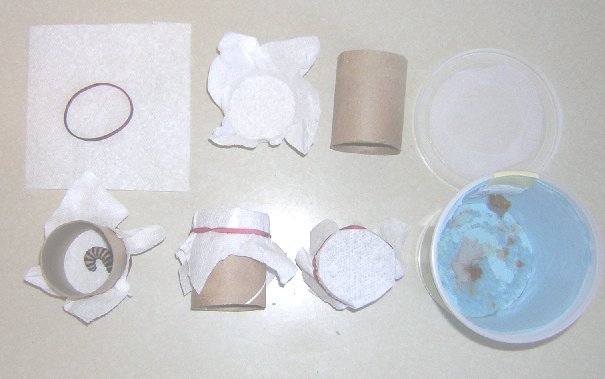 |
| Closed Container Method
setup for a "soon-to-purge" fifth instar P. indra minori
caterpillar:
Since mature larvae consume roughly three sprigs per day, it is advantageous to only place what sprigs the larva would consume in a 12 hour period--which is the timeframe in between your morning and evening procedure--in order to avoid condensation in the container and keep frass as dry as possible. |
The Gizmo: A pupation/emergence
setup for P. indra:
Take a toilet tissue core and [vertically] cut in half. Take a 4" by 4" square of paper towel and fasten around the top of core with rubber band. Place larva that has already purged into gizmo--see lower left figure. Turn gizmo around so that larva cannot escape and place in a dark area--see lower figure second from the right. Upon pupation, place pupa into emergence container--see figure lower right. (Gizmo design courtesy Bruce Dolen.) |
The Potted Plant Method:
A third alternative is the potted plant method. As shown on Dr. Whaley's webpage, having potted hostplant can have several advantages including a nice setup for getting females to oviposit. This setup can also be advantageous for rearing a low number of caterpillars where suitable hostplant is remote. Obviously, with this method, worries about changing hostplant, larval sickness, etc are taken out of play. Note: Be sure to put a screen or netting around hostplant so that larvae cannot escape.
The best way to setup this method is to grow Lomatium and Cymopterus spp. from seed. The best time to harvest seeds is roughly one to two months after the plant has gone to flower.
Matrix of Papilio indra Subspecies vs. Documented Larval Foodplants and Suitable Lab Substitutes in Utah
|
|
||||
|
Lomatium
grayi var. “grayi” |
NO
|
NO |
NO
|
NO* |
|
NO |
NO
|
NO
|
dLF
|
|
|
YES
|
dLF
|
YES
|
YES
|
|
|
dLF
|
YES!
|
YES!
|
YES!
|
|
|
???
|
dLF
|
dLF
|
Later instars only |
|
|
???
|
???
|
dLF
|
NO
|
|
|
YES
|
dLF
|
YES |
YES |
dLF==Documented Larval Foodplant.
YES==Suitable Lab Foodplannt.
(Produces Adults)
NO==Not
Suitable Lab Foodplant.
???==Unknown
*
Larvae accept L. grayi
grayi
in
the lab; but pupae seldom emerge as healthy adults.
REFERENCES:
1. Emmel, Thomas C. and Emmel, John F. 1973. The Butterflies of
Southern
California
p. 12.
2. Howe, William H. 1975. The Butterflies of North America p. 396.
3. Ferris, Clifford D. and Brown, F. Martin 1981. Butterflies of the
Rocky Mountain States p. 184.
4. Comstock, John Adams. 1927. The Butterflies of California. p. 21.
5. Gillette, C.F. Col. Utahensis: Journal of the Utah
Lepidopterists' Society 1984 4•2, p. 34.
6. Whaley, W.H. Personal Communication. 17 Jul 1996.
7. Whaley, W.H. Personal Communication. Aug, 1999.
8.
Gillette, C.F. Col. Personal Communication. 5 Jul 1996.
10. Whaley, W.H. Personal Communication. 30 May 2004.